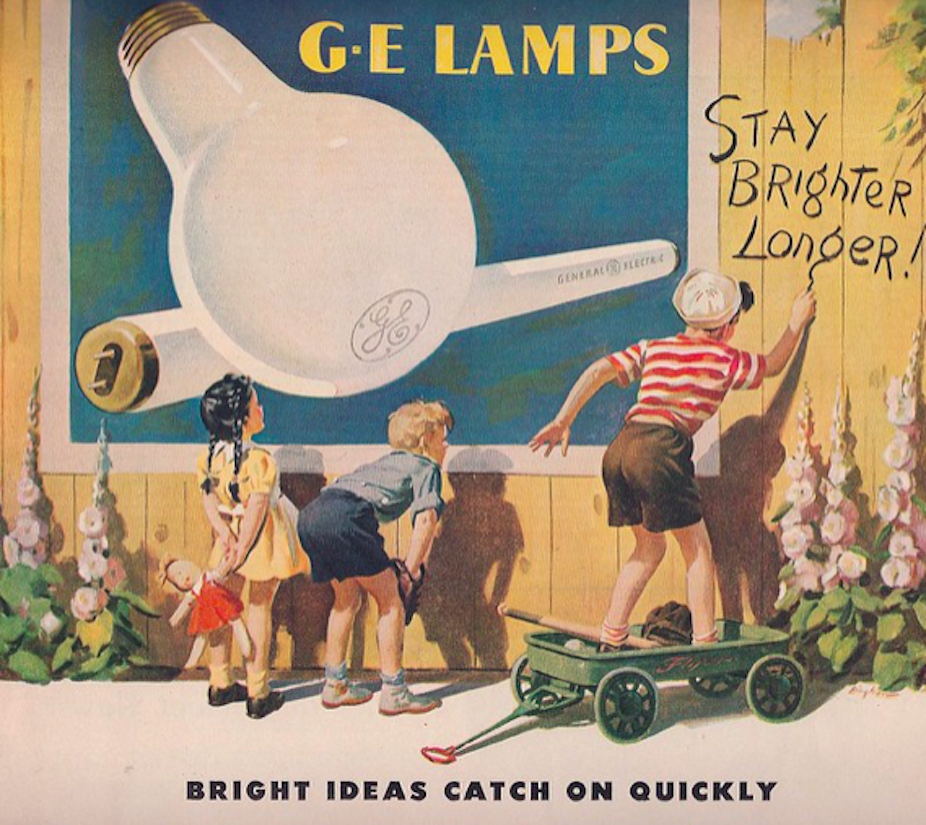After nearly 130 years in business and a series of breakthrough innovations that shaped the way we light up our homes, General Electric has sold its lighting division to the US-based market leader in smart homes, Savant, for a reported US$250 million (£198 million). While a licensing agreement means that consumers will continue to see GE-branded light bulbs in stores, the sale marks the end of an era for this quintessential giant of the illumination industry.
GE traces its roots to Thomas Edison’s invention of the electric light bulb in 1879. Since then, GE Lighting and its direct legal predecessors have shaped illumination technology like no other company: building on Edison’s legacy, the company went on to patent the tungsten filament in 1912 and the first practical fluorescent tubes in 1927.
Further breakthroughs came with the halogen light bulb in 1958 and the first visible-light LED in 1962. It was priced at US$260 (around £1,750 in today’s money), yet was so dim its red glimmer was barely visible. A more recent breakthrough came in 2015, when GE released its ultra narrow-band phosphors for light conversion in LED bulbs and television sets, claiming more vibrant colours and higher efficiency.
GE’s greatest hits

LEDs enter the lighting market
Though General Electric and other American household names like Hewlett-Packard and Texas Instruments were experimenting with LEDs in the 1960s, the devices produced only a dim light and their application was restricted to pocket calculators and digital watches. To propel the industry forward, it took several breakthroughs by Japanese scientists in the 1980s (they later won the 2014 Nobel Prize in Physics). This increased LED brightness dramatically, and their use in mass-market lighting now became a real possibility.
In the 1990s, Japanese chemical company Nichia took the lead, patenting several key technologies related to LED lighting. They competed against other early adopters like Toyoda Gosei in Japan, Cree in the United States and Osram Opto Semiconductor in Europe.
GE Lighting was not among them and did not prioritise LED research in the same way. This meant it was not well placed to capitalise when LEDs moved from being niche products to the mass market after 2010, when energy efficiency regulations were introduced by the US and EU. These “light bulb bans” quickly saw incandescent bulbs disappear from shelves.
Total installed lamps in EU 1990-2020

LED bulbs soon made their way into consumer’s homes, and prices fell dramatically as the LED chip became commoditised. This trend was accelerated when China made a bombshell decision to enter the market around 2010. The move came as part of the government’s 12th five-year industrial plan, which laid out major investments in LED research and development, as well as manufacturing capacity. A nationwide energy efficiency programme created the world’s largest market for LED bulbs and helped kickstart the industry.
Initially lagging in performance, Chinese lighting companies have since caught up. Semiconductor giant MLS now claims a capacity of 30 billion LED chips per month, making it the world’s largest LED manufacturer. Following its 2016 acquisition of Osram’s general lighting branch Ledvance, it now competes with companies like Philips and Cree that have dominated the LED lighting market ever since their early adoption of the technology.
Some western LED manufacturers like Philips and Osram were able to respond to this new Chinese competition in bulbs because they had developed high-performance products for specialised higher margin applications. These included automotive and aerospace lighting, ultraviolet light for water disinfection and large-scale horticulture.
GE Lighting, which had remained focused on general illumination, lacked the R&D capacity to make a similar move. It retrenched to the US in 2016, and was put up for sale by GE as part of a wider restructuring to cut down on its towering corporate debt. The company, once famed for its electrical household appliances, is now no longer selling to consumers at all.
LEDs evolve beyond lighting
Chinese manufacturers’ investment in device research is likely to continue to grow, so current high-margin markets can soon be expected to see the same downward price pressure as LED bulbs. GE first failed to embrace LED bulbs and then to invest in the research and development that could have helped it enter into higher margin markets as prices fell. A similar fate now awaits other manufacturers if they fail to recognise that LEDs have evolved far beyond lighting.
There lie ahead exciting new technologies enabled by decades of LED research and development: quantum communication using specialised LEDs; augmented-reality glasses with micro-LED displays embedded into eyeglass lenses (see below); and LED lighting-based “Li-Fi”, which is expected to exceed the capacity of current wifi radio transmission without performance drawbacks caused by interference from overlapping signals.

Intensive research in these areas means that western companies currently have an edge on these technologies. Most recently, UK-based semiconductor manufacturer Plessey, specialising in micro-LED manufacturing, announced a partnership with Facebook, while Google is investing heavily into a Swedish micro-LED university spinoff. Both tech giants are hoping to be first to market with their augmented-reality products, based on micro-LED displays.
Our research at the Cambridge Centre for Environment, Energy and Natural Resource Governance, in collaboration with Harvard Kennedy School and the University of Minnesota, shows that these are only a few applications of LED technology in other sectors.

